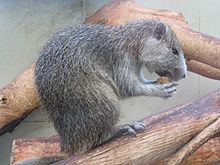| Hutia Temporal range:
| |
|---|---|

| |
| Desmarest's hutia (Capromys pilorides) | |
| Scientific classification | |
| Domain: | Eukaryota |
| Kingdom: | Animalia |
| Phylum: | Chordata |
| Class: | Mammalia |
| Order: | Rodentia |
| Family: | Echimyidae |
| Subfamily: | Capromyinae Smith, 1842 |
| Type genus | |
| Capromys Desmarest, 1822
| |
| Genera | |
|
Tribe Capromyini Tribe Plagiodontini †Tribe Hexolobodontini †Tribe Isolobodontini | |
Hutias (known in Spanish as jutía[1]) are moderately large cavy-like rodents of the subfamily Capromyinae that inhabit the Caribbean islands. Most species are restricted to Cuba, but species are known from all of the Greater Antilles, as well as The Bahamas and (formerly) Little Swan Island off of Honduras.
Twenty species of hutia have been identified, but at least half are extinct. Only Desmarest's hutia and the prehensile-tailed hutia remain common and widespread; all other extant species are considered threatened by the IUCN.
The extinct giant hutias of the family Heptaxodontidae also inhabited the Caribbean, but are not thought to be closely related, with the giant hutias belonging in the superfamily Chinchilloidea.[2]
- ^ "Cuba's government mocked by stampede of ostrich memes". BBC News. 23 April 2019.
- ^ Fabre, Pierre-Henri; Vilstrup, Julia T.; Raghavan, Maanasa; Der Sarkissian, Clio; Willerslev, Eske; Douzery, Emmanuel J. P.; Orlando, Ludovic (July 2014). "Rodents of the Caribbean: origin and diversification of hutias unravelled by next-generation museomics". Biology Letters. 10 (7). doi:10.1098/rsbl.2014.0266. ISSN 1744-9561. PMC 4126619. PMID 25115033.